Cameos of Railroading
I recently completed these two compositions. Both were made for fun and as a way to practice techniques and play with different materials.
Composition No. One: When The Railroad Leaves Town
In this one I used a triangle shape to break from the traditional rectangular form often applied to such pieces. The shape provides a more dynamic interior space to compose with. I purposely avoided having the track at right angles or parallel to any of the edges and also used the clumps of the grass to repeat the triangle form. Doing this helps the inside relate to the outside in a harmonious way.
I paid special attention to the tie color. Even though the ties had a basic wash, I added more and felt successful in capturing the bleached colors and tones of older creosote and wood. In addition, I dusted everything with weathering powders and actual dirt to bring it all together. The thing I’m truly surprised by is how the painted rail heads blend the track into the landscape. As suggested by the title, this is a recently abandoned line that nature will eventually reclaim.
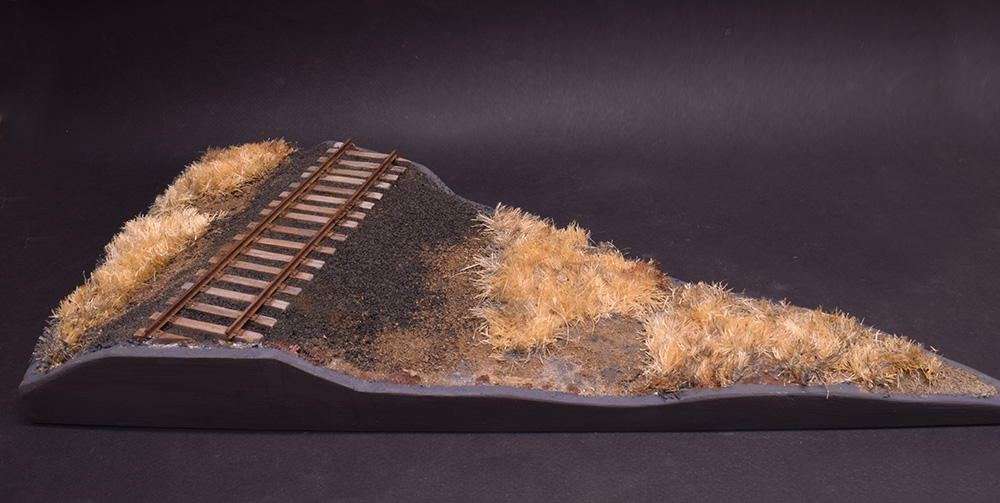
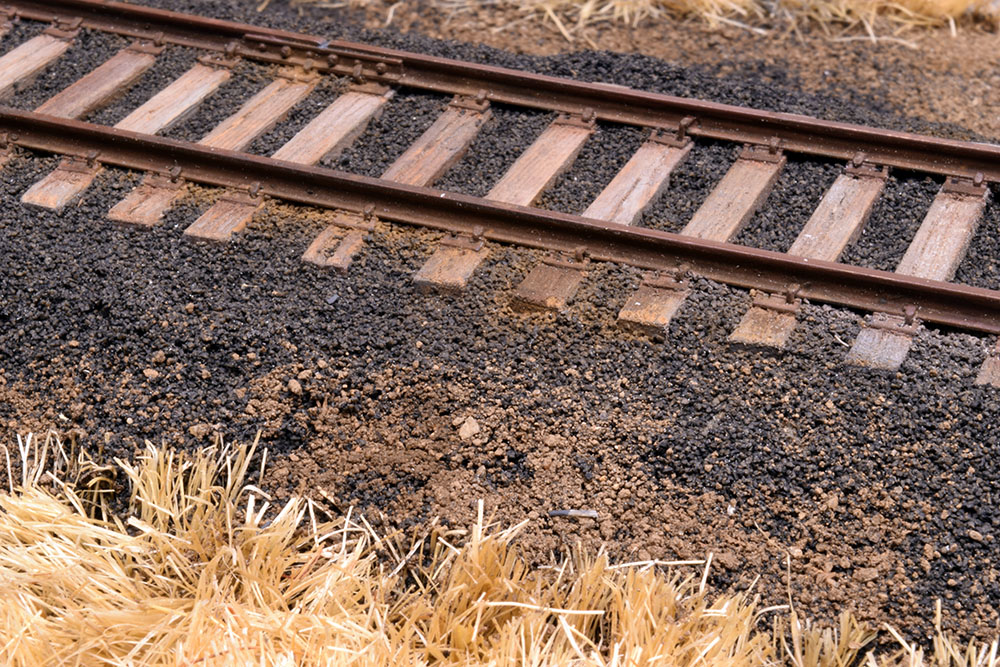
Composition No. Two: Excuse Me Coming Through
This piece was a further experiment with modeling track in pavement. Again, I played with the overall shape and interior composition. The line of the curbside and the shape of the road surface and ground, along with the track are all deliberate choices. Nothing is parallel and the gentle curve gives a more dynamic sightline than straight track would have. The actual radius is around 48 inches, which is quite sharp for quarter-inch scale.
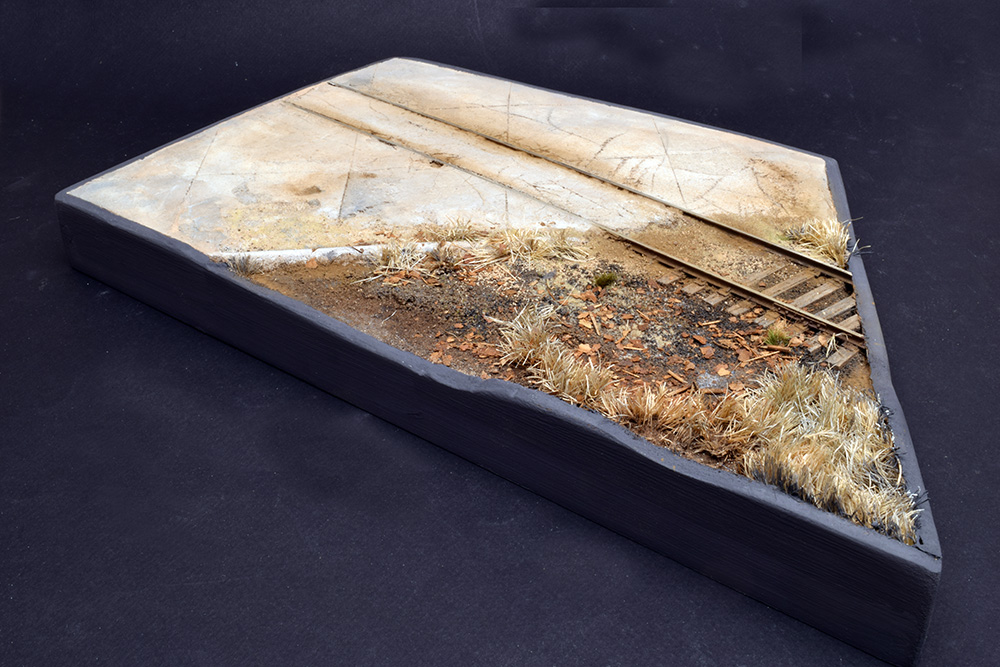
I imagined a long industrial branch weaving its way through the street grid, parking lots and back alleys that are full of the places in between mentioned in this post.
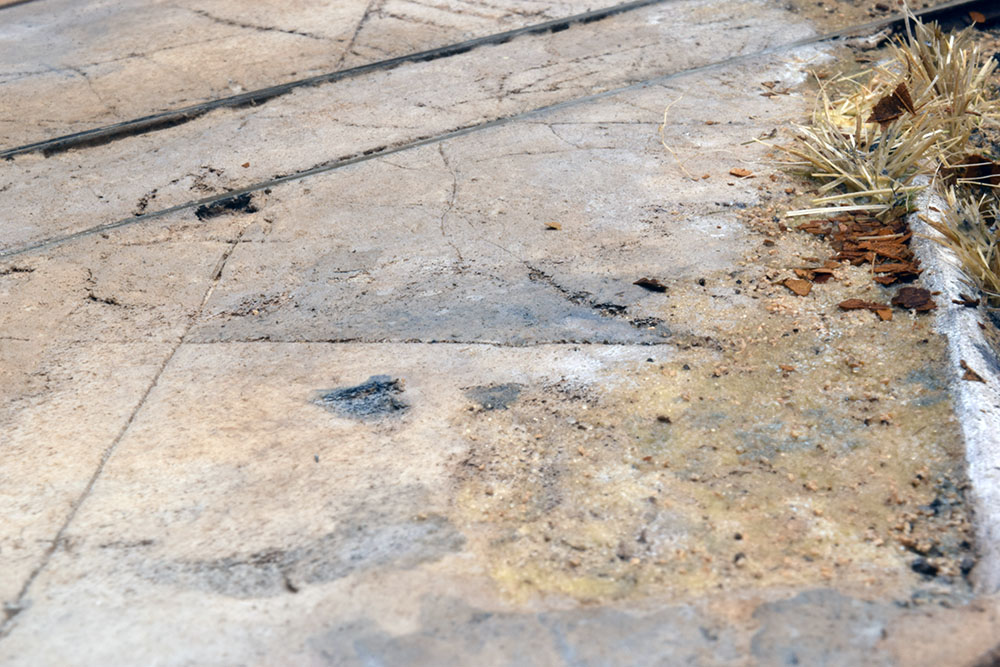
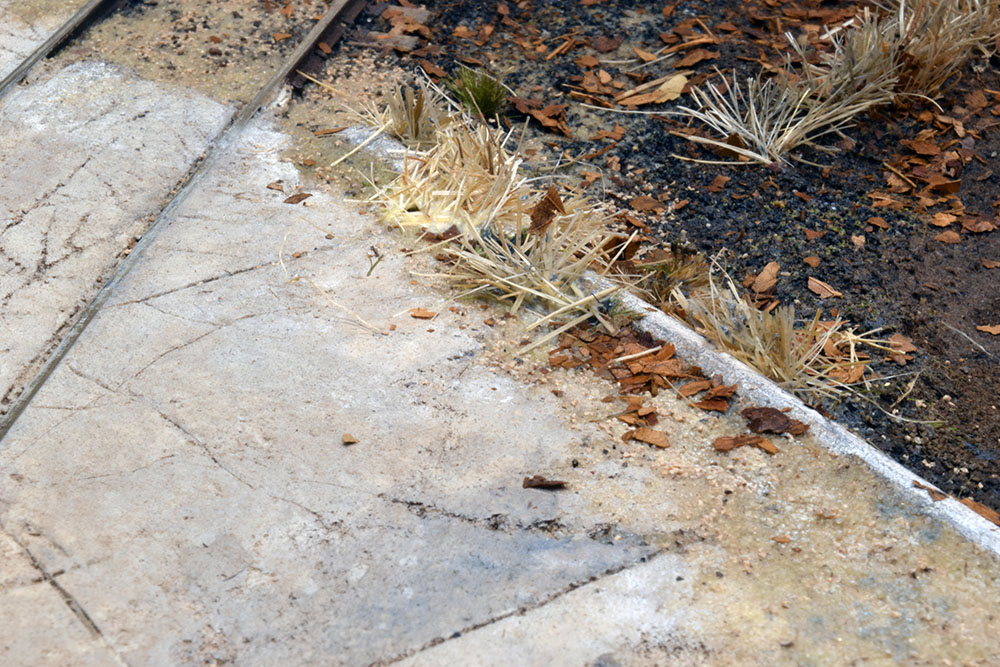

Of particular interest in this piece was refining the techniques of modeling pavement. I started with the idea of doing a brick surface but quickly abandoned that choice. The regularity of plastic brick sheets didn’t appeal at alI. I’ve used foam core board as a road surface before and went that route here. I peel off one of the paper layers to expose the core and apply a thin coating of lightweight spackling compound. While this piece looks better than previous efforts, I’m not pleased with how the foam tears when I try to carve cracks and expansion joint lines. A razor saw worked better for the joint lines and I’m still looking for a better way of doing the cracks. The one distinct advantage of using the foam board is the lightweight nature of the material compared to the equivalent amount of plaster or joint compound. For a small piece like this, weight isn’t an issue but it could add up over a larger surface. It’s a choice of what’s important to you. I prefer more realism and would go with the techniques used in this early post from my old layout.
Concrete Color
My focus was on refining the color of old concrete and I feel good about the outcome on this piece. It’s a simple mix of three colors using a wet-in-wet technique that is easy to replicate if the need arises. The base coat is Tamiya (XF-78) Wooden Deck Tan applied full strength with a brush. While this layer is still wet, I applied washes of (XF-66) Light Gray and (XF-2) Flat White that were thinned with denatured alcohol for the final color. These washes vary greatly from very fluid to more opaque. They stain the base color more than cover it. In my experiments, the white seems to be the key ingredient for getting the tone right. You don’t want a heavy layer and I lifted the paint off in spots with a paper towel and applied another wash until I saw what I wanted in the surface. As with most color, applying these washes is subjective and the only way to learn is by doing it until you see results you like.
I made notes on the procedure and was able to closely match the color afterward when the road needed some touchup. Any slight variations will be blended together with further weathering steps. One could vary the basic colors in the mix for a warmer or cooler tone to match a concrete sample. There’s lots of room for experimentation here.
I mentioned that doing these was an enjoyable diversion. The compact size allows for easy completion and that alone is satisfying. They make an excellent playground for trying new ideas with little or nothing to loose in the process. In this sense, they are a wonderful way to just relax and model for the sheer enjoyment it can bring. I’m also learning that design isn’t decoration or something you tack on to a work; it’s a way of approaching a project from the outset.
Such pieces are a good proving ground to expand or refine your techniques and are also an excellent way to introduce and share the craft with others.
Best regards,
Mike
for scribing foam, try using a ball-point pen, Bic fine lines work well for me, but I work in 1/35th, YMMV
Lovely. And a really important concept: the small practice study.
I am particularly struck by the lack of trees, bushes or other vertical elements. It sets the mood/tone so well, focusing the view on the brilliant track modeling. In these you’ve chosen to really dive into the details–it makes sense–but I also see these as interesting petri dishes to practice subtraction of necessary elements, to explore what is necessary and what isn’t, as Greg briefly mentioned in his comments to the last blog post.
The biggest hurdle for most people will be the base shapes which can influence the impact so directly as yours demonstrate. The balance between the shape of the base and the modeled subject is key so that the shape doesn’t dominate at the expense of losing the subject.
For inspiration and learning growth I’d hang these on the wall above the area I was working on, much like I hang studies for paintings near my easel.
Thanks for sharing these gems.
I love these, Mike. Great study pieces to further your craft, and art pieces in and of themselves. I agree with Dave’s comment that the would be geeat candidates for a wall.
Andrew, Chris and Dave,
Thanks guys. I appreciate the thoughts and suggestion.
Andrew, I’m going to try your idea of using a pen to carve the foam.
Dave, it interests me to know what you see in a piece like these. The lack of vertical elements wasn’t planned, there just wasn’t room for any. I thought of adding a utility pole or fence post in the far corner of the first composition but never tried it to see if it would work visually.
Chris, I picture them sitting on a shelf or small table instead of a wall. They could work either way.
Mike
These are quite smart looking models and I can feel inspiration kicking in here–I see some things I want to try here in Halifax motivated by what you’ve done.
I usually default to approximately rectangular forms in my study pieces but that’s as much functional of the size of scrap foam I grab at the time as it is my lack of creativity and thought process. Your more deliberate use of more natural and contemplative forms for the footprint of these studies makes them quite attractive to look at. In a way this feeds back into thoughts on the overall shape of our model railway’s. We default to square tables as the frames for our layouts and these can be unattractive until we’re immersed into the scene. Looser, more organic forms, where the footprint of the scene draws lines from within the scene not only connect things in an intentional-design way but also create a form that’s attractive to look at from far away–inviting and drawing us by speaking to our curiousity.
Your signature jute grass looks really sharp in the first composition. This grass technique was another of those things that attracted me to start working in O scale. I’m struggling with finding a tall grass medium I like and since most of my track should be framed by it, it’s a thing I need to keep exploring. Your cinder-ballasted track reminds me of my own work and your beautiful finished model reminds me to “get on with it” and get back to exploring long grass here.
Paved roads are my nemesis. Like any good and frustrating tease I have only one ever made paved roads I was pleased with the look of and it’s been decades since that happened. I know plaster is just a shortcut to frustration for me because it feels disconnected to my creative process, the finished material is too fine to “feel” like asphalt (even in O), and it’s mostly just a mess in my hands. Your use of foam core looks like something I should be trying more and since I have the material it’s a thing I need to try. While the long grass is something I “need” for the current layout project I don’t have an immediate need of a paved road so this time, right now, is a perfect moment for tangential work I can return to later when the need is more immediate and integrated more directly.
Thank you, again, always.
Chris
Thanks for sharing your system for painting concrete, Mike.
Dan
Chris,
It’s always gratifying to know the blog serves as inspiration for someone. Thank you. As you are discovering, scenery textures take on a new dimension as you move up in scale.
Mike
Hi Dan,
You’re welcome. I hope both ideas help your modeling.
Mike
Hi Mike,
I agree with Chris,” We default to square tables as the frames for our layouts and these can be unattractive until we’re immersed into the scene”. Do you think these kinds of shapes could work for a layout as well as the cameo?
Gordon
Hi Gordon,
I think they could with some out of the box thinking. I don’t have Chris’s imagination for design but could see a small switching scenario in a triangular shape and we could certainly do better than straight runs of fascia everywhere. Straight and square are easy to build and use materials efficiently but I agree they can become boring and predictable. What do you think?
Mike